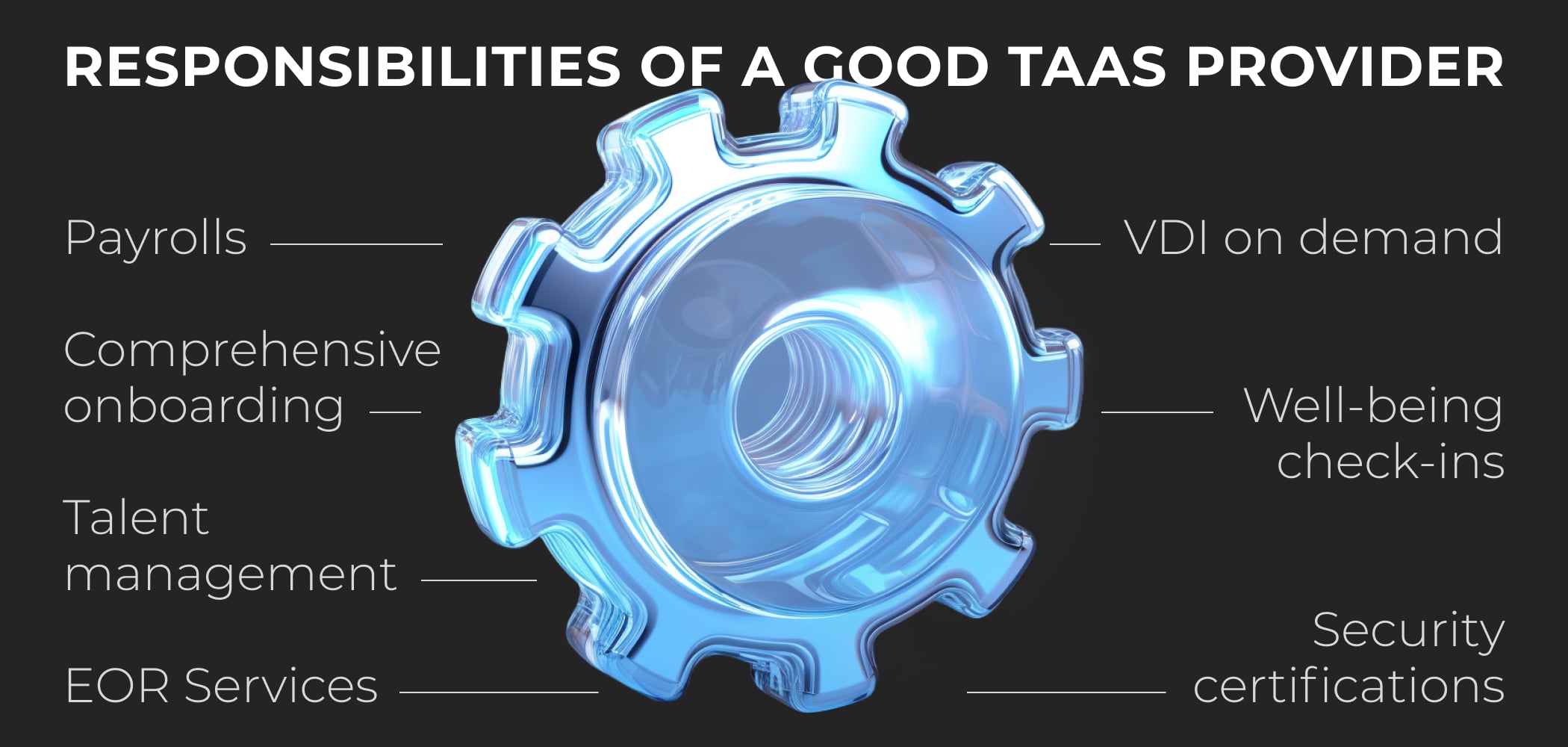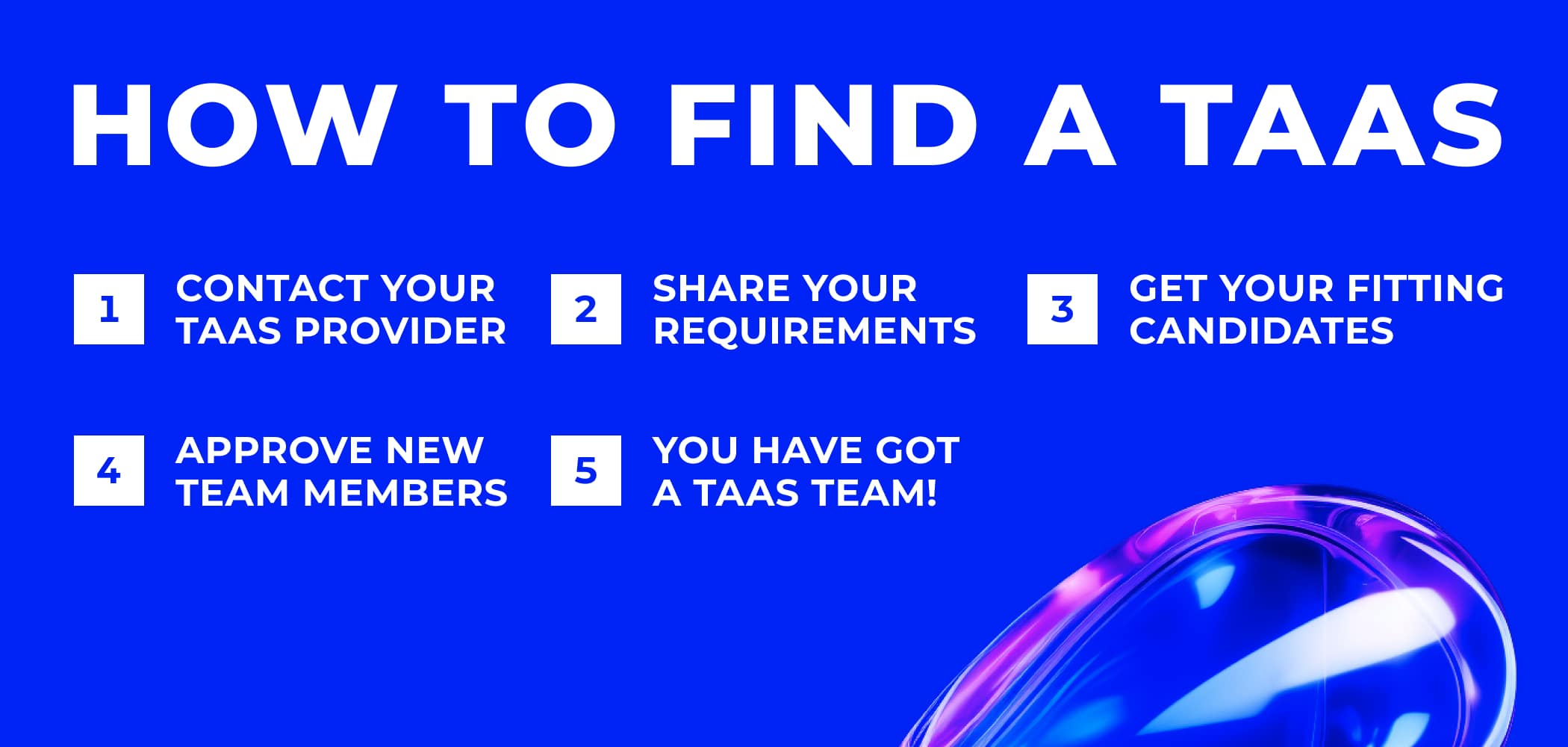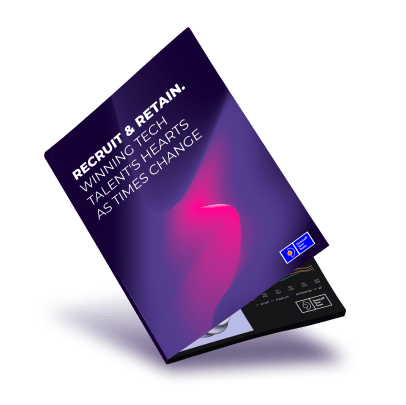The talent shortage in the global IT and tech sector makes 76% and 97% of mid-size IT departments face difficulties when hiring, according to the statistics provided by market researchers.
Scientists argue that it was Albert Einstein who said, “Insanity is doing the same thing over and over again and expecting different results.” Yet, this saying perfectly describes the motivation of tech businesses to explore decentralized teams.
Let's see how Team as a Service can address the dynamic staffing requirements of tech projects.
What Is TaaS?
The Team as a Service, often abbreviated as TaaS, is a relatively new hiring model popular in the IT business. Unlike with traditional hiring, with TaaS, you can quickly onboard a dedicated team, pre-assembled according to your project requirements.
A TaaS team consists of experts in various fields, such as software development, design, quality assurance, project management, etc. You decide on what team structure you need.

Why May You Need Teams as a Service?
The main reason to pay attention to the team as a service model is to delegate all the People Ops, offloading the management and creating agile development teams which stimulate innovation. Below, you can see 4 success factors you can get if start utilizing TaaS for developing your tech business.
Scalability. If project scopes change rapidly, TaaS allows you to scale your team up, ensuring you have the right people working on your project at the right time. Whether you need a short-term team for a specific project or a long-term collaboration, this model adapts to your requirements, ensuring your business remains agile in the face of change.
Expertise on Demand. What about simplifying your hunting for tech talent? You pay for the expertise and don’t have to invest in the in-house HR department, study the laws related to hiring and be responsible for taxes and payrolls. TaaS ensures you cooperate with a highly skilled team of professionals who have mastered the latest technologies and are aware of the industry trends. This expertise can be especially beneficial when you're dealing with niche projects that require specialized skills.
Complete Control of Projects. Your team reports directly to you, as opposed to outsourcing where you usually contact only the project manager who advocates your task performers.
Faster Time to Market. Assembling an in-house team can take time, delaying your project kick-off. TaaS providers pick seasoned specialists and build a ready-to-go team. At the early hiring stages, they ensure the compatibility of team members with each other and with your project.
With TaaS, you could remove such possible stoppers as talent shortage, struggling with engaging specialists on a project basis, and misunderstandings with freelancers or third-party companies performing your project tasks.
As a result, you will have a chance to become more independent of your budget restrictions and talent market shifts and can realize bolder plans with more impressive outcomes.
How to Get the Most Out of Your TaaS Provider?
To harness all the benefits of the TaaS cooperation model, consider partnering with the TaaS provider which offers a wide range of talent management services. outstaffing enthusiasts have already begun to separate Team as a Service and Talent as a Service. Team as a Service focuses on gathering teams for specific projects. Talent as a Service refers to tapping into a global pool of contract specialists after custom talent market research is done for each of your positions.
While both concepts are finally taking root, you can face some confusion between them, surfing through different sources. So, we suggest you just remember the 8 strategic functions of any good tech team provider.

These functions are helpful when you are planning to attract one new performer to your team, as well as when you are outstaffing the whole team.
Are There Any Pitfalls of a TaaS Model?
Everything goes smoothly if you are collaborating with respective teams. What do we mean here? Well, when engaging the development team as a service, pay attention to their approach to business ethics. We’ve prepared a basic checklist for you.
Concern #1. TaaS teams might be geographically dispersed. Differences in time zones and communication tools could impact real-time collaboration and project understanding.
Your TaaS provider should establish transparent and unified communication channels and leverage digital collaboration tools. Plus, outstaffing professionals hire globally to unite team members from the compatible time zones, and arrange check-ins with the team to ensure everyone is on the same page.
Concern #2. Working with a diverse team from different regions can enrich your project with unique perspectives. However, it might also lead to clashes due to cultural differences and varying work approaches.
Experienced TaaS providers embrace cultural diversity as a strength and create inclusive work environments.
Concern #3. While TaaS offers autonomy, your business might become dependent on third-party expertise, potentially affecting your internal team's growth and skills development.
First-class TaaS providers bring team players who work closely with the rest of the team. All the knowledge and expertise accumulate inside your company.
Concern#4. When sharing sensitive project information with an external team, you should think about how they store shared data.
By partnering with GDPR-compliant and ISO-certified TaaS providers, you can protect your intellectual property. Such outstaffing agencies undertake to protect personal and confidential data. Altogether, consider the use of VDI for your company to have full control over all the generated data and track all the actions applied to it.
Concern #5. Integrating a TaaS team seamlessly into your existing company culture and processes can be complex.
But not when your TaaS provider picks culturally fit candidates and engages dedicated specialists who devote 100% of their working time to your project.
Is It Long To Gather a TaaS Team?
We believe that launching TaaS is less energy-consuming for a business than launching a traditional team. You form your requirements, communicate only with hand-picked potential hires, and confirm or reject them.

The duration of each stage depends on the project’s complexity and the number of team players you want to engage. On average, Outstaff Your Team introduces the first candidates to the clients in 6–11 days after the start of the hiring campaign.
Ready to acquire a higher position in the rating of the most valuable tech stocks? Then, you are on the right web page now, as you can make us your TaaS provider. We know how to hire programmers for a startup, where to find the best (not the most expensive) back-end developers for hire, and what skills to examine to hire front-end developers with spotless reputations. For the 12 years on the market, we have filtered IT hiring practices that work and bring results. That’s why you can enjoy your partnership with smoothly-running tech team very soon.
FAQ
What is the team as a service process?
Team as a Service (TaaS) is when a third-party service provider hires the entire development team or certain team members for your project. You identify development needs and share them with a TaaS provider. That provider composes a team of professionals with the required skills and expertise. For the IT sector, this team can include Software Engineers, Project Managers, QA Engineers, and Designers. Your TaaS team is integrated into your workflow and processes via communication channels and project management tools. You, together with your TaaS provider, define your contract length, which is flexible and can be short-term (from 3 months) as well as long-term (based on your project requirements).
TaaS cooperation model vs. hiring freelancers: Which to choose?
If you have budget constraints or need short-term assistance, hiring freelancers may be a cost-effective choice. You should have time and expertise to manage freelancers while TaaS provider does it for you. Plus, your HR partners can: 1) find rare specialists beyond the freelance market; and 2) scale your extended team up on your demand, so you don’t think about how to arrange everything, including payrolls and long-term motivation of team members. That’s why, companies tend to opt for a TaaS model to be more flexible.
What types of projects are the most suitable for Team as a Service?
Team as a Service is suitable for a variety of projects and business scenarios. It excels in software and web development, digital marketing campaigns, graphic design, content creation, data analysis, and product development. TaaS is also ideal for e-commerce store management, quality assurance, long- and short-term projects. Startups often use it for MVP development, and it's valuable for projects with fluctuating scopes or requiring specialized expertise. This model allows you to assemble flexible, remote teams tailored to your project's needs, scale them up when necessary, and disband them when the project concludes. Whether you need a small, specialized team or a larger, multidisciplinary one, TaaS provides a cost-effective and agile solution to meet your project goals effectively.
Stay in tune
Curated Tech HR buzz delivered to your inbox



